Law 10: Insolvency Law: Directors' Duties, ASIC, and Stakeholders
VerifiedAdded on 2020/03/02
|11
|2559
|90
Essay
AI Summary
This essay delves into the intricacies of insolvency law, examining the definition of insolvency under the Corporations Act 2001 and the signs that indicate a company's financial distress. It explores the duties and liabilities of company directors, particularly concerning insolvent trading as defined by Section 588G of the Act, and the consequences of breaching these duties. The essay outlines the options available to companies and directors facing insolvency, including seeking professional advice, voluntary administration, and creditor's winding up. It contrasts voluntary and involuntary interventions and discusses the role of ASIC in deregistering companies. Furthermore, the essay highlights the current statistics on insolvency in Australia and critiques the existing insolvency laws, suggesting potential improvements by drawing parallels with other international practices and considering the long-term prospects of companies. The paper concludes by summarizing the key aspects of insolvency, emphasizing the importance of understanding the roles of all stakeholders involved.

Running Head: Law 1
Law
Law
Paraphrase This Document
Need a fresh take? Get an instant paraphrase of this document with our AI Paraphraser
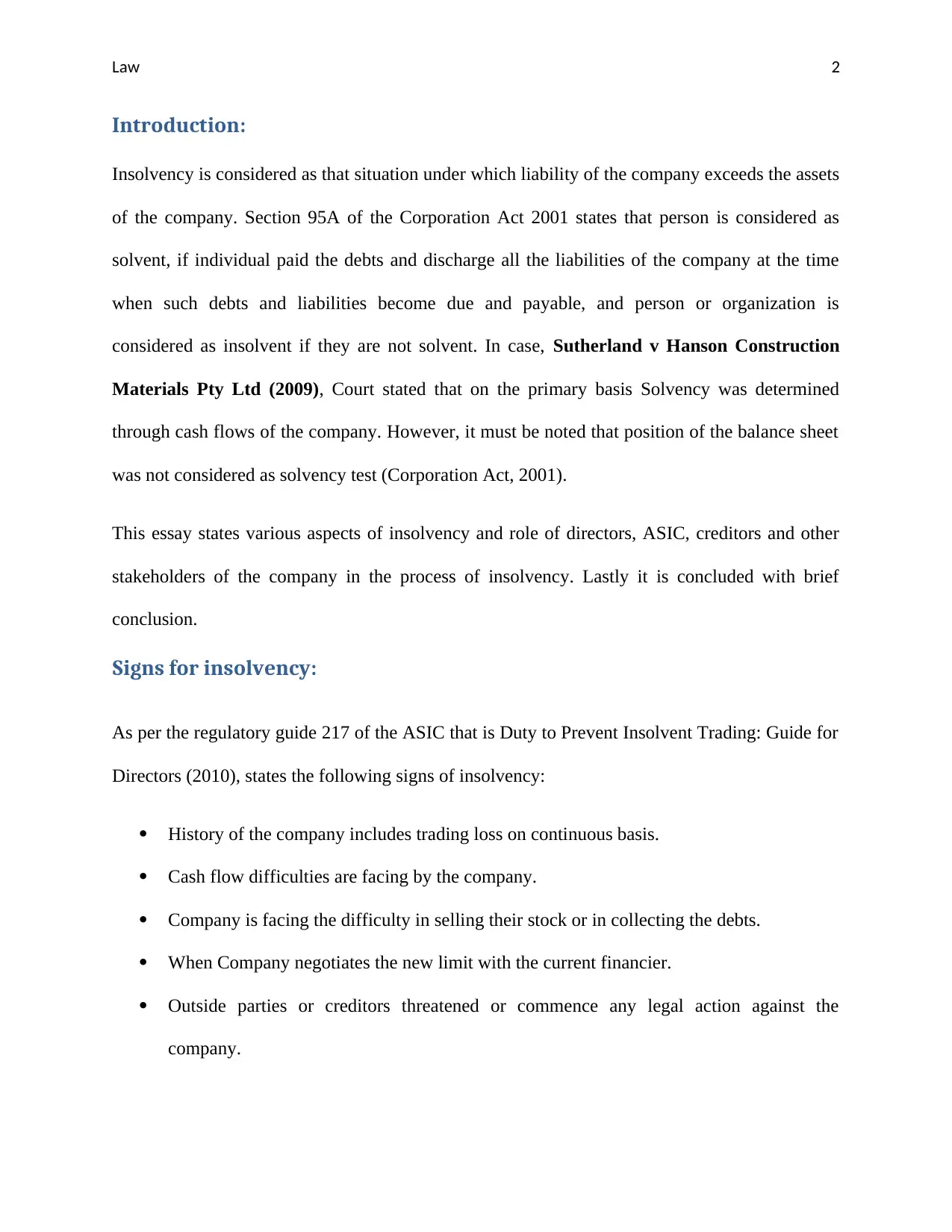
Law 2
Introduction:
Insolvency is considered as that situation under which liability of the company exceeds the assets
of the company. Section 95A of the Corporation Act 2001 states that person is considered as
solvent, if individual paid the debts and discharge all the liabilities of the company at the time
when such debts and liabilities become due and payable, and person or organization is
considered as insolvent if they are not solvent. In case, Sutherland v Hanson Construction
Materials Pty Ltd (2009), Court stated that on the primary basis Solvency was determined
through cash flows of the company. However, it must be noted that position of the balance sheet
was not considered as solvency test (Corporation Act, 2001).
This essay states various aspects of insolvency and role of directors, ASIC, creditors and other
stakeholders of the company in the process of insolvency. Lastly it is concluded with brief
conclusion.
Signs for insolvency:
As per the regulatory guide 217 of the ASIC that is Duty to Prevent Insolvent Trading: Guide for
Directors (2010), states the following signs of insolvency:
History of the company includes trading loss on continuous basis.
Cash flow difficulties are facing by the company.
Company is facing the difficulty in selling their stock or in collecting the debts.
When Company negotiates the new limit with the current financier.
Outside parties or creditors threatened or commence any legal action against the
company.
Introduction:
Insolvency is considered as that situation under which liability of the company exceeds the assets
of the company. Section 95A of the Corporation Act 2001 states that person is considered as
solvent, if individual paid the debts and discharge all the liabilities of the company at the time
when such debts and liabilities become due and payable, and person or organization is
considered as insolvent if they are not solvent. In case, Sutherland v Hanson Construction
Materials Pty Ltd (2009), Court stated that on the primary basis Solvency was determined
through cash flows of the company. However, it must be noted that position of the balance sheet
was not considered as solvency test (Corporation Act, 2001).
This essay states various aspects of insolvency and role of directors, ASIC, creditors and other
stakeholders of the company in the process of insolvency. Lastly it is concluded with brief
conclusion.
Signs for insolvency:
As per the regulatory guide 217 of the ASIC that is Duty to Prevent Insolvent Trading: Guide for
Directors (2010), states the following signs of insolvency:
History of the company includes trading loss on continuous basis.
Cash flow difficulties are facing by the company.
Company is facing the difficulty in selling their stock or in collecting the debts.
When Company negotiates the new limit with the current financier.
Outside parties or creditors threatened or commence any legal action against the
company.
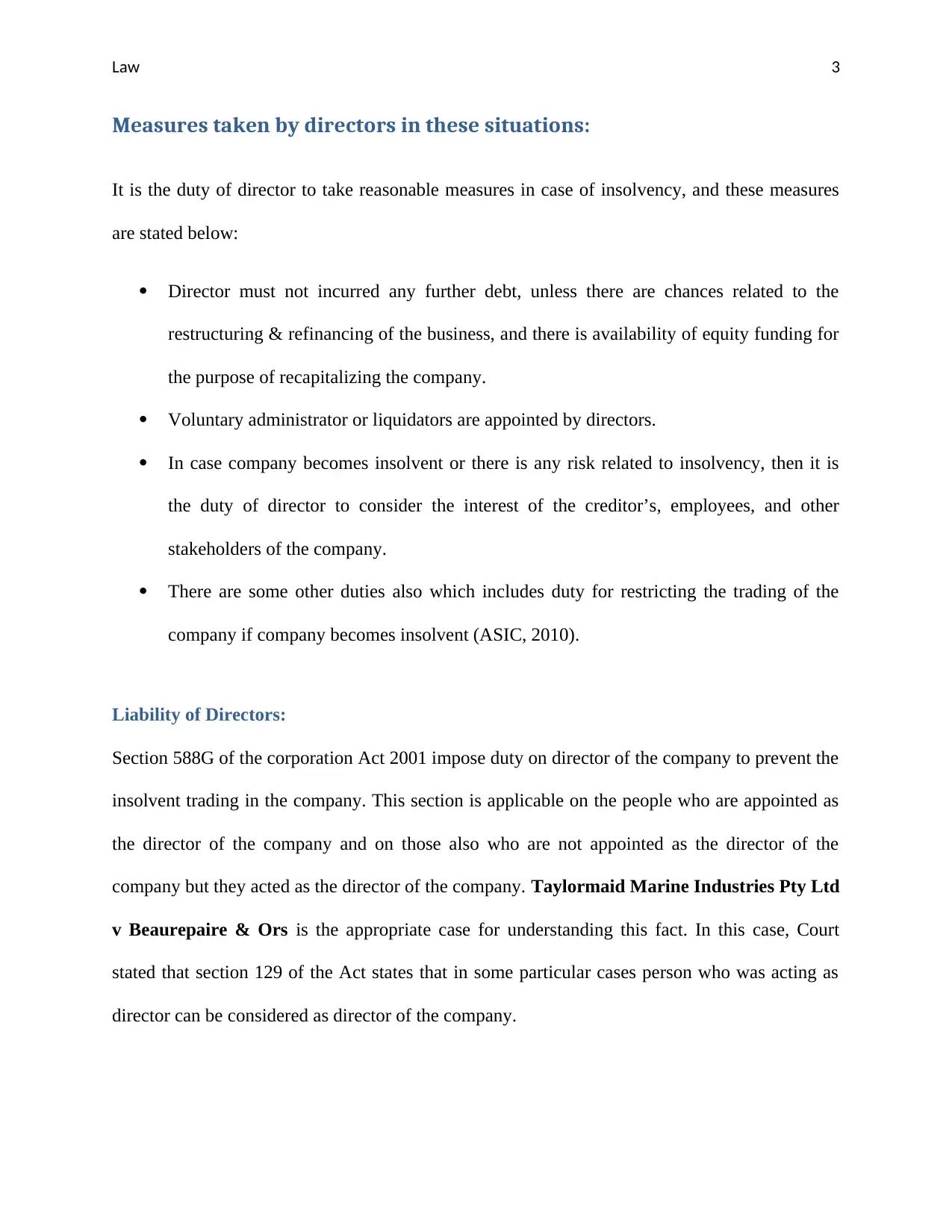
Law 3
Measures taken by directors in these situations:
It is the duty of director to take reasonable measures in case of insolvency, and these measures
are stated below:
Director must not incurred any further debt, unless there are chances related to the
restructuring & refinancing of the business, and there is availability of equity funding for
the purpose of recapitalizing the company.
Voluntary administrator or liquidators are appointed by directors.
In case company becomes insolvent or there is any risk related to insolvency, then it is
the duty of director to consider the interest of the creditor’s, employees, and other
stakeholders of the company.
There are some other duties also which includes duty for restricting the trading of the
company if company becomes insolvent (ASIC, 2010).
Liability of Directors:
Section 588G of the corporation Act 2001 impose duty on director of the company to prevent the
insolvent trading in the company. This section is applicable on the people who are appointed as
the director of the company and on those also who are not appointed as the director of the
company but they acted as the director of the company. Taylormaid Marine Industries Pty Ltd
v Beaurepaire & Ors is the appropriate case for understanding this fact. In this case, Court
stated that section 129 of the Act states that in some particular cases person who was acting as
director can be considered as director of the company.
Measures taken by directors in these situations:
It is the duty of director to take reasonable measures in case of insolvency, and these measures
are stated below:
Director must not incurred any further debt, unless there are chances related to the
restructuring & refinancing of the business, and there is availability of equity funding for
the purpose of recapitalizing the company.
Voluntary administrator or liquidators are appointed by directors.
In case company becomes insolvent or there is any risk related to insolvency, then it is
the duty of director to consider the interest of the creditor’s, employees, and other
stakeholders of the company.
There are some other duties also which includes duty for restricting the trading of the
company if company becomes insolvent (ASIC, 2010).
Liability of Directors:
Section 588G of the corporation Act 2001 impose duty on director of the company to prevent the
insolvent trading in the company. This section is applicable on the people who are appointed as
the director of the company and on those also who are not appointed as the director of the
company but they acted as the director of the company. Taylormaid Marine Industries Pty Ltd
v Beaurepaire & Ors is the appropriate case for understanding this fact. In this case, Court
stated that section 129 of the Act states that in some particular cases person who was acting as
director can be considered as director of the company.
⊘ This is a preview!⊘
Do you want full access?
Subscribe today to unlock all pages.

Trusted by 1+ million students worldwide
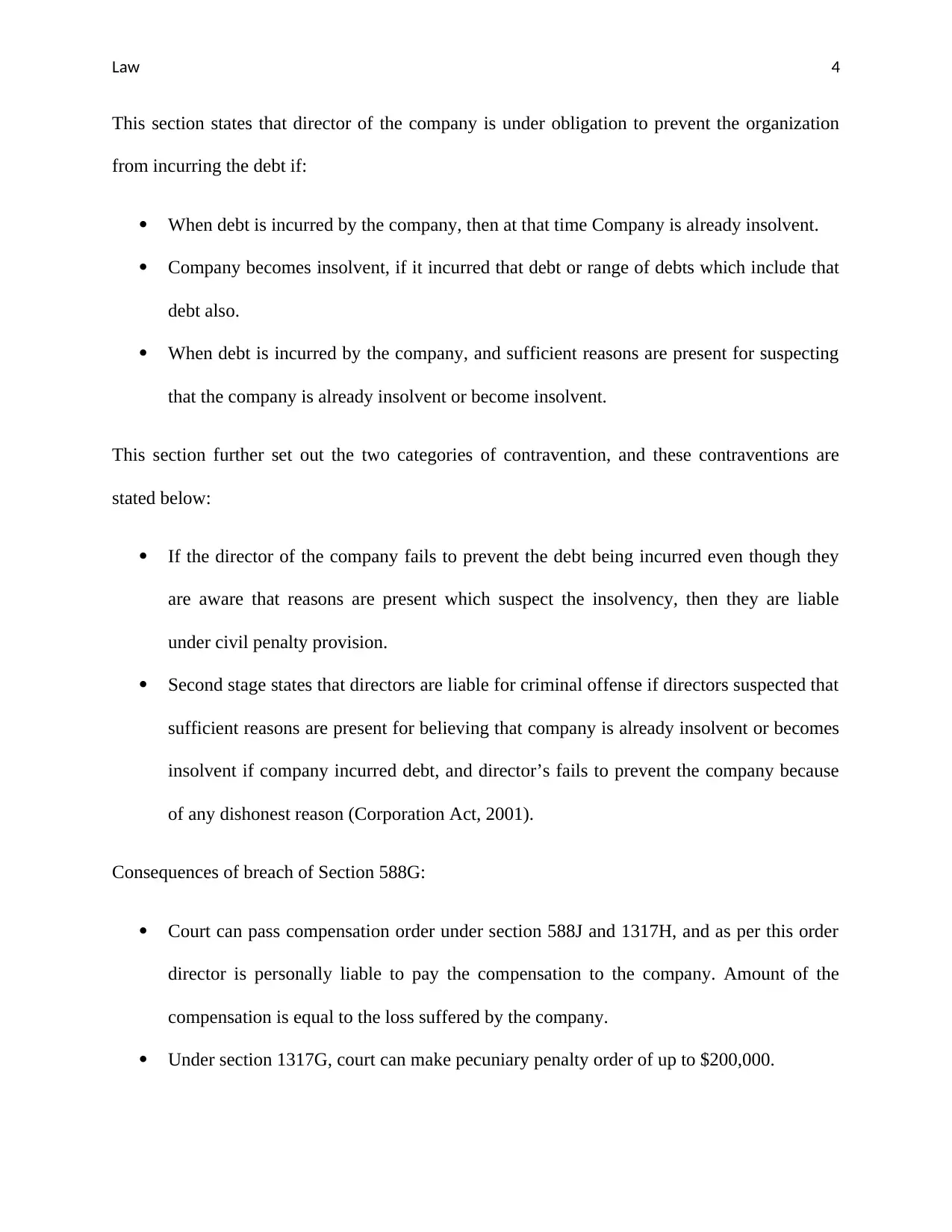
Law 4
This section states that director of the company is under obligation to prevent the organization
from incurring the debt if:
When debt is incurred by the company, then at that time Company is already insolvent.
Company becomes insolvent, if it incurred that debt or range of debts which include that
debt also.
When debt is incurred by the company, and sufficient reasons are present for suspecting
that the company is already insolvent or become insolvent.
This section further set out the two categories of contravention, and these contraventions are
stated below:
If the director of the company fails to prevent the debt being incurred even though they
are aware that reasons are present which suspect the insolvency, then they are liable
under civil penalty provision.
Second stage states that directors are liable for criminal offense if directors suspected that
sufficient reasons are present for believing that company is already insolvent or becomes
insolvent if company incurred debt, and director’s fails to prevent the company because
of any dishonest reason (Corporation Act, 2001).
Consequences of breach of Section 588G:
Court can pass compensation order under section 588J and 1317H, and as per this order
director is personally liable to pay the compensation to the company. Amount of the
compensation is equal to the loss suffered by the company.
Under section 1317G, court can make pecuniary penalty order of up to $200,000.
This section states that director of the company is under obligation to prevent the organization
from incurring the debt if:
When debt is incurred by the company, then at that time Company is already insolvent.
Company becomes insolvent, if it incurred that debt or range of debts which include that
debt also.
When debt is incurred by the company, and sufficient reasons are present for suspecting
that the company is already insolvent or become insolvent.
This section further set out the two categories of contravention, and these contraventions are
stated below:
If the director of the company fails to prevent the debt being incurred even though they
are aware that reasons are present which suspect the insolvency, then they are liable
under civil penalty provision.
Second stage states that directors are liable for criminal offense if directors suspected that
sufficient reasons are present for believing that company is already insolvent or becomes
insolvent if company incurred debt, and director’s fails to prevent the company because
of any dishonest reason (Corporation Act, 2001).
Consequences of breach of Section 588G:
Court can pass compensation order under section 588J and 1317H, and as per this order
director is personally liable to pay the compensation to the company. Amount of the
compensation is equal to the loss suffered by the company.
Under section 1317G, court can make pecuniary penalty order of up to $200,000.
Paraphrase This Document
Need a fresh take? Get an instant paraphrase of this document with our AI Paraphraser
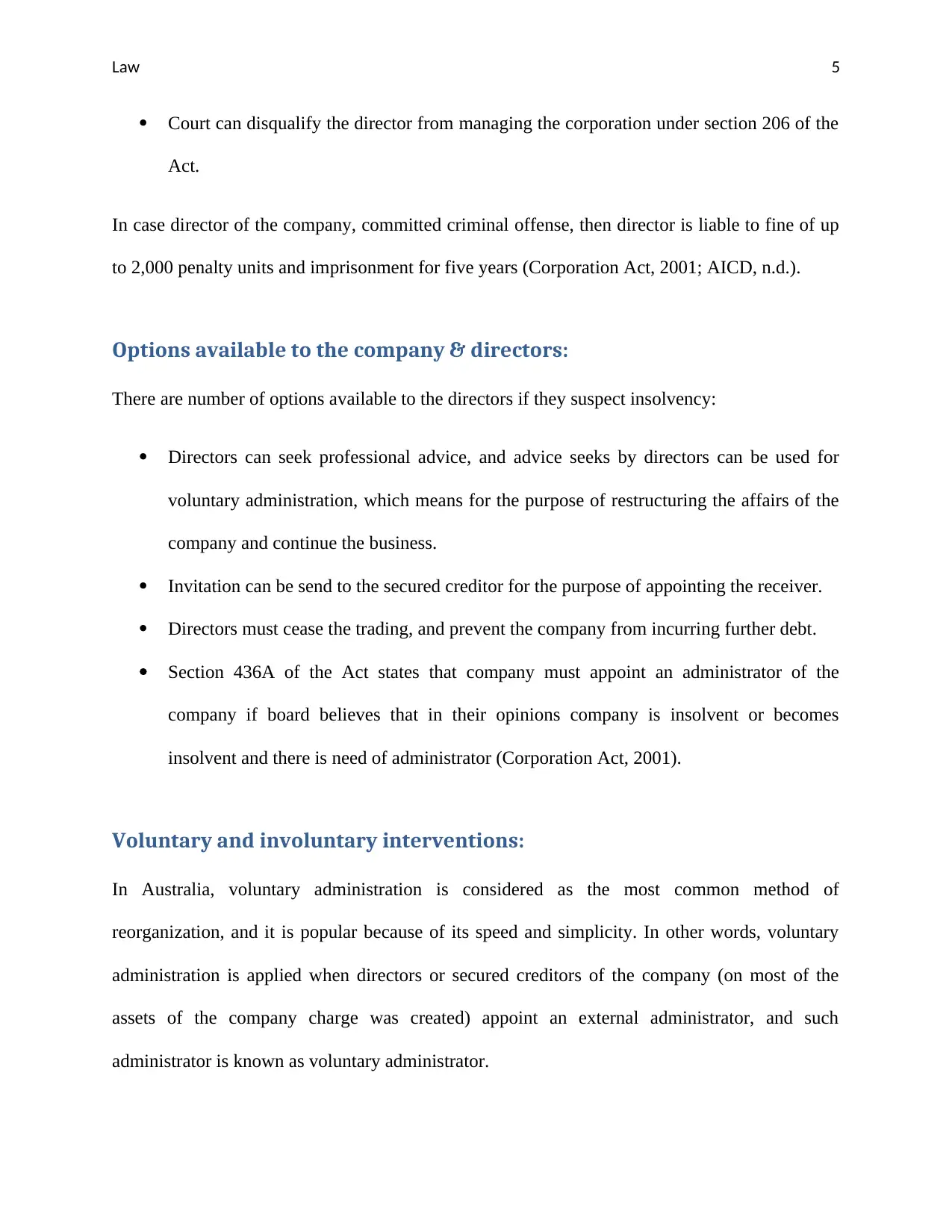
Law 5
Court can disqualify the director from managing the corporation under section 206 of the
Act.
In case director of the company, committed criminal offense, then director is liable to fine of up
to 2,000 penalty units and imprisonment for five years (Corporation Act, 2001; AICD, n.d.).
Options available to the company & directors:
There are number of options available to the directors if they suspect insolvency:
Directors can seek professional advice, and advice seeks by directors can be used for
voluntary administration, which means for the purpose of restructuring the affairs of the
company and continue the business.
Invitation can be send to the secured creditor for the purpose of appointing the receiver.
Directors must cease the trading, and prevent the company from incurring further debt.
Section 436A of the Act states that company must appoint an administrator of the
company if board believes that in their opinions company is insolvent or becomes
insolvent and there is need of administrator (Corporation Act, 2001).
Voluntary and involuntary interventions:
In Australia, voluntary administration is considered as the most common method of
reorganization, and it is popular because of its speed and simplicity. In other words, voluntary
administration is applied when directors or secured creditors of the company (on most of the
assets of the company charge was created) appoint an external administrator, and such
administrator is known as voluntary administrator.
Court can disqualify the director from managing the corporation under section 206 of the
Act.
In case director of the company, committed criminal offense, then director is liable to fine of up
to 2,000 penalty units and imprisonment for five years (Corporation Act, 2001; AICD, n.d.).
Options available to the company & directors:
There are number of options available to the directors if they suspect insolvency:
Directors can seek professional advice, and advice seeks by directors can be used for
voluntary administration, which means for the purpose of restructuring the affairs of the
company and continue the business.
Invitation can be send to the secured creditor for the purpose of appointing the receiver.
Directors must cease the trading, and prevent the company from incurring further debt.
Section 436A of the Act states that company must appoint an administrator of the
company if board believes that in their opinions company is insolvent or becomes
insolvent and there is need of administrator (Corporation Act, 2001).
Voluntary and involuntary interventions:
In Australia, voluntary administration is considered as the most common method of
reorganization, and it is popular because of its speed and simplicity. In other words, voluntary
administration is applied when directors or secured creditors of the company (on most of the
assets of the company charge was created) appoint an external administrator, and such
administrator is known as voluntary administrator.
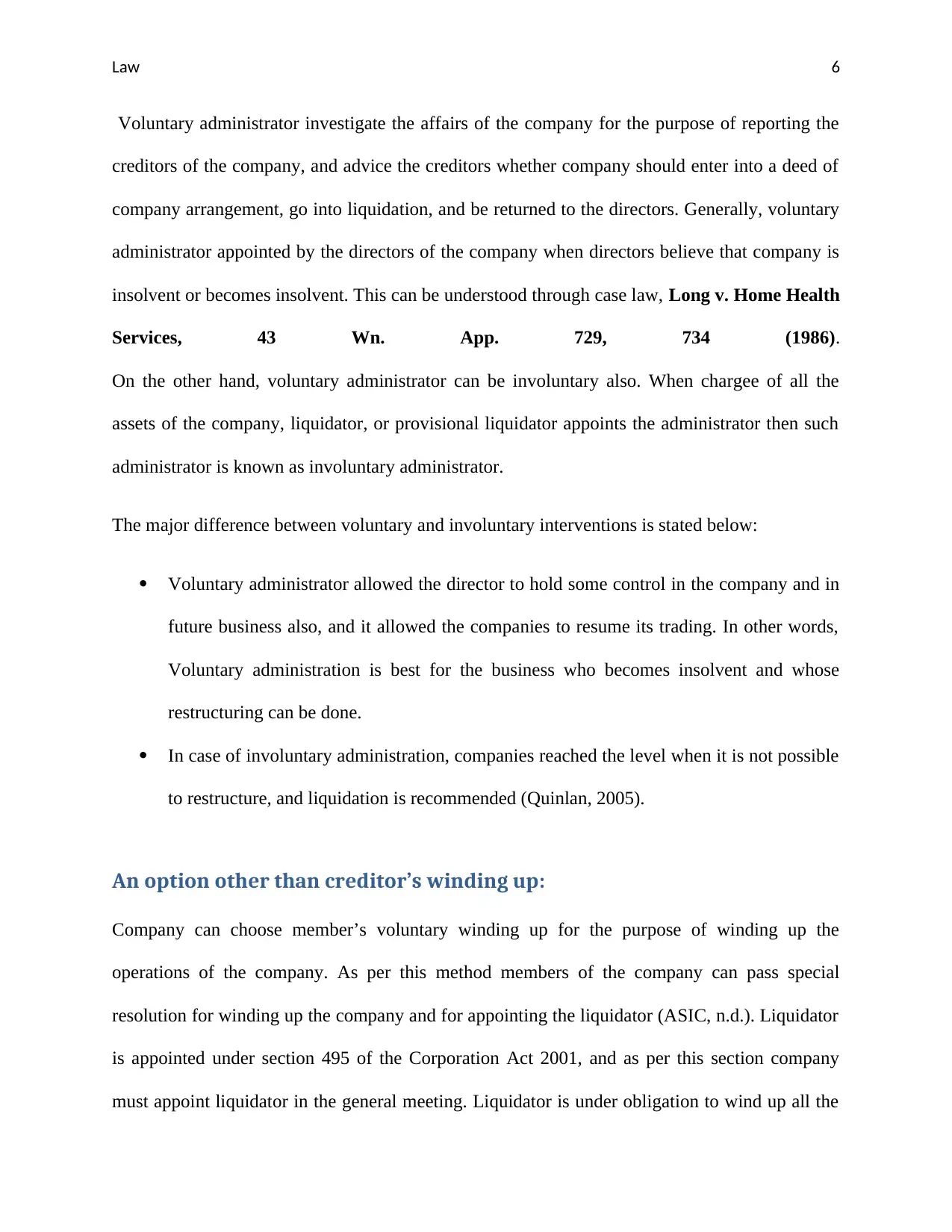
Law 6
Voluntary administrator investigate the affairs of the company for the purpose of reporting the
creditors of the company, and advice the creditors whether company should enter into a deed of
company arrangement, go into liquidation, and be returned to the directors. Generally, voluntary
administrator appointed by the directors of the company when directors believe that company is
insolvent or becomes insolvent. This can be understood through case law, Long v. Home Health
Services, 43 Wn. App. 729, 734 (1986).
On the other hand, voluntary administrator can be involuntary also. When chargee of all the
assets of the company, liquidator, or provisional liquidator appoints the administrator then such
administrator is known as involuntary administrator.
The major difference between voluntary and involuntary interventions is stated below:
Voluntary administrator allowed the director to hold some control in the company and in
future business also, and it allowed the companies to resume its trading. In other words,
Voluntary administration is best for the business who becomes insolvent and whose
restructuring can be done.
In case of involuntary administration, companies reached the level when it is not possible
to restructure, and liquidation is recommended (Quinlan, 2005).
An option other than creditor’s winding up:
Company can choose member’s voluntary winding up for the purpose of winding up the
operations of the company. As per this method members of the company can pass special
resolution for winding up the company and for appointing the liquidator (ASIC, n.d.). Liquidator
is appointed under section 495 of the Corporation Act 2001, and as per this section company
must appoint liquidator in the general meeting. Liquidator is under obligation to wind up all the
Voluntary administrator investigate the affairs of the company for the purpose of reporting the
creditors of the company, and advice the creditors whether company should enter into a deed of
company arrangement, go into liquidation, and be returned to the directors. Generally, voluntary
administrator appointed by the directors of the company when directors believe that company is
insolvent or becomes insolvent. This can be understood through case law, Long v. Home Health
Services, 43 Wn. App. 729, 734 (1986).
On the other hand, voluntary administrator can be involuntary also. When chargee of all the
assets of the company, liquidator, or provisional liquidator appoints the administrator then such
administrator is known as involuntary administrator.
The major difference between voluntary and involuntary interventions is stated below:
Voluntary administrator allowed the director to hold some control in the company and in
future business also, and it allowed the companies to resume its trading. In other words,
Voluntary administration is best for the business who becomes insolvent and whose
restructuring can be done.
In case of involuntary administration, companies reached the level when it is not possible
to restructure, and liquidation is recommended (Quinlan, 2005).
An option other than creditor’s winding up:
Company can choose member’s voluntary winding up for the purpose of winding up the
operations of the company. As per this method members of the company can pass special
resolution for winding up the company and for appointing the liquidator (ASIC, n.d.). Liquidator
is appointed under section 495 of the Corporation Act 2001, and as per this section company
must appoint liquidator in the general meeting. Liquidator is under obligation to wind up all the
⊘ This is a preview!⊘
Do you want full access?
Subscribe today to unlock all pages.

Trusted by 1+ million students worldwide
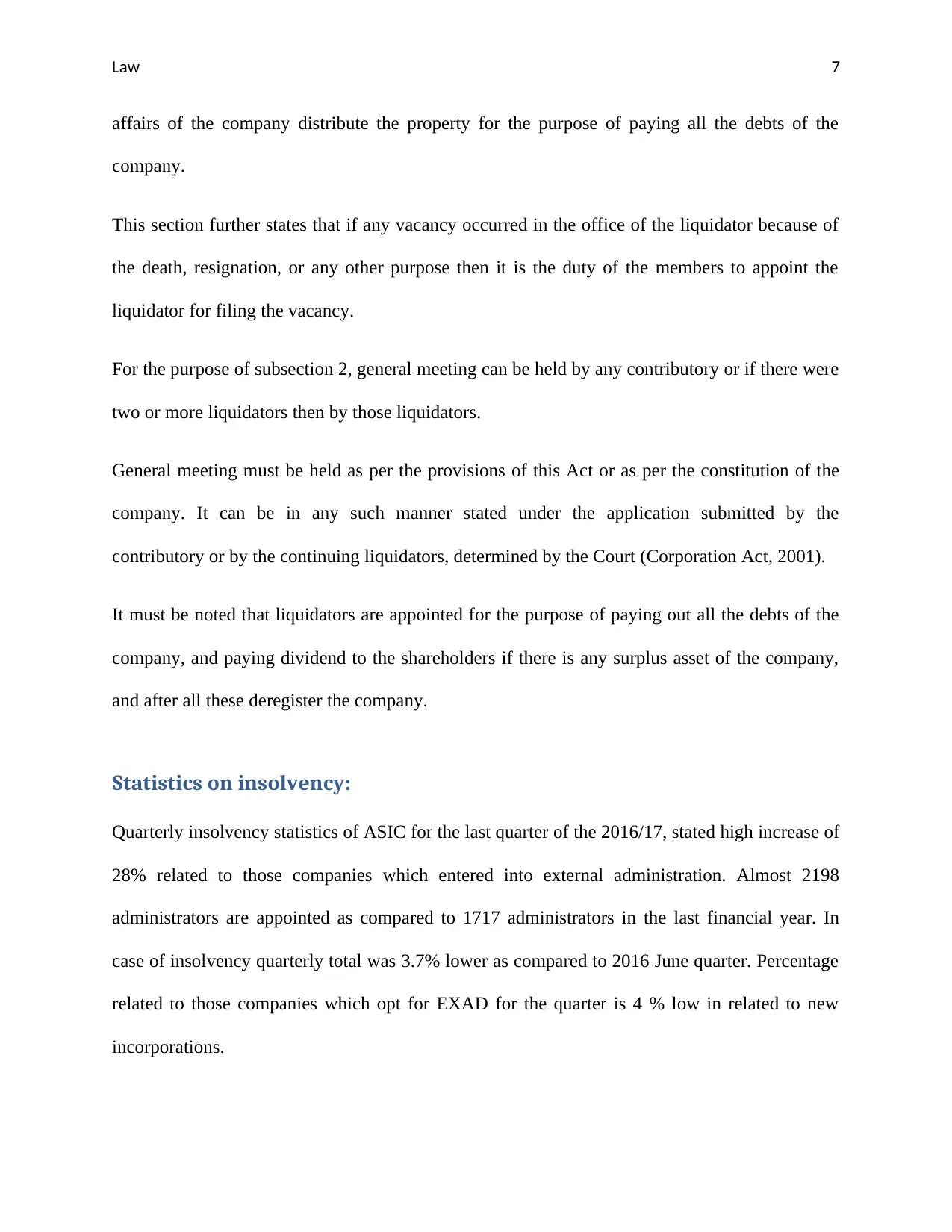
Law 7
affairs of the company distribute the property for the purpose of paying all the debts of the
company.
This section further states that if any vacancy occurred in the office of the liquidator because of
the death, resignation, or any other purpose then it is the duty of the members to appoint the
liquidator for filing the vacancy.
For the purpose of subsection 2, general meeting can be held by any contributory or if there were
two or more liquidators then by those liquidators.
General meeting must be held as per the provisions of this Act or as per the constitution of the
company. It can be in any such manner stated under the application submitted by the
contributory or by the continuing liquidators, determined by the Court (Corporation Act, 2001).
It must be noted that liquidators are appointed for the purpose of paying out all the debts of the
company, and paying dividend to the shareholders if there is any surplus asset of the company,
and after all these deregister the company.
Statistics on insolvency:
Quarterly insolvency statistics of ASIC for the last quarter of the 2016/17, stated high increase of
28% related to those companies which entered into external administration. Almost 2198
administrators are appointed as compared to 1717 administrators in the last financial year. In
case of insolvency quarterly total was 3.7% lower as compared to 2016 June quarter. Percentage
related to those companies which opt for EXAD for the quarter is 4 % low in related to new
incorporations.
affairs of the company distribute the property for the purpose of paying all the debts of the
company.
This section further states that if any vacancy occurred in the office of the liquidator because of
the death, resignation, or any other purpose then it is the duty of the members to appoint the
liquidator for filing the vacancy.
For the purpose of subsection 2, general meeting can be held by any contributory or if there were
two or more liquidators then by those liquidators.
General meeting must be held as per the provisions of this Act or as per the constitution of the
company. It can be in any such manner stated under the application submitted by the
contributory or by the continuing liquidators, determined by the Court (Corporation Act, 2001).
It must be noted that liquidators are appointed for the purpose of paying out all the debts of the
company, and paying dividend to the shareholders if there is any surplus asset of the company,
and after all these deregister the company.
Statistics on insolvency:
Quarterly insolvency statistics of ASIC for the last quarter of the 2016/17, stated high increase of
28% related to those companies which entered into external administration. Almost 2198
administrators are appointed as compared to 1717 administrators in the last financial year. In
case of insolvency quarterly total was 3.7% lower as compared to 2016 June quarter. Percentage
related to those companies which opt for EXAD for the quarter is 4 % low in related to new
incorporations.
Paraphrase This Document
Need a fresh take? Get an instant paraphrase of this document with our AI Paraphraser
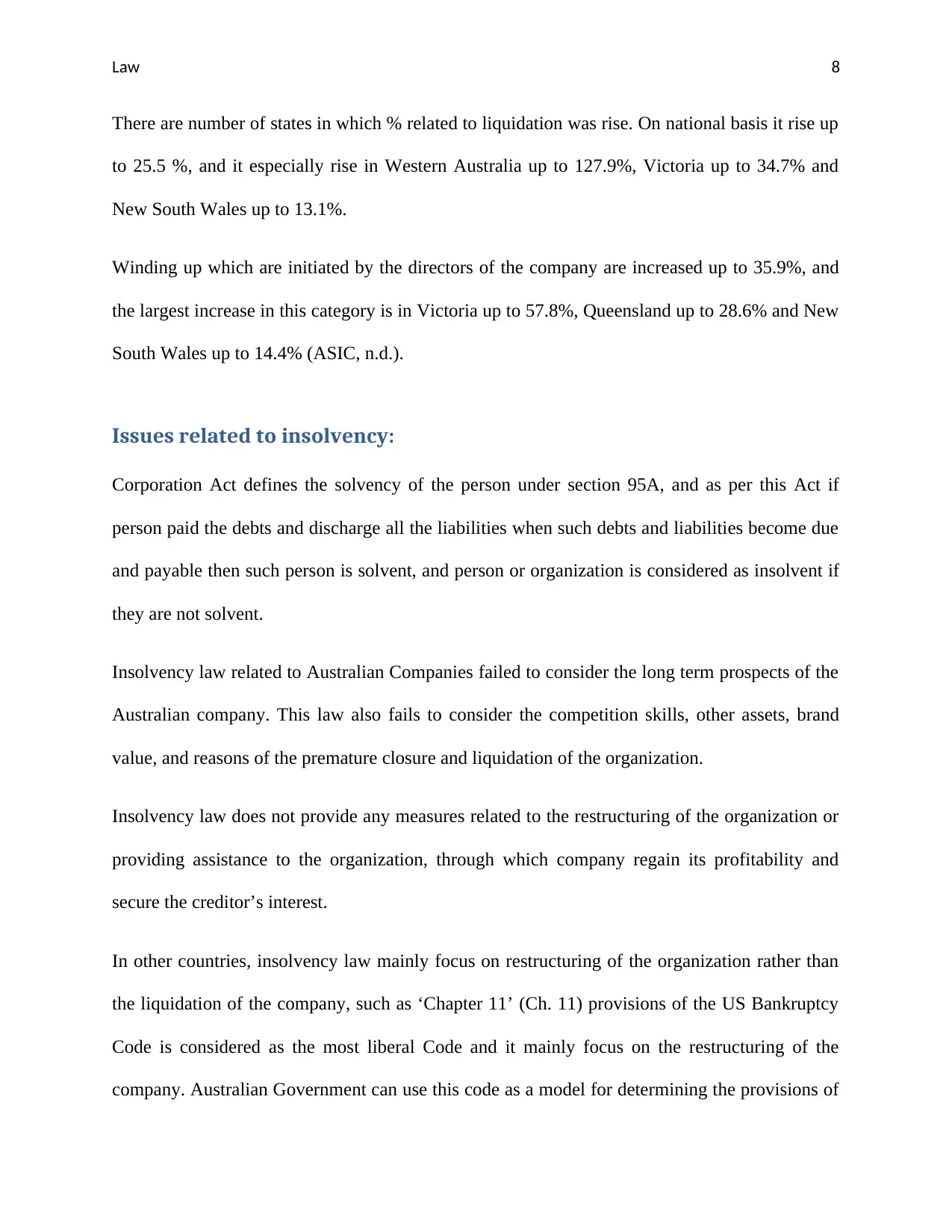
Law 8
There are number of states in which % related to liquidation was rise. On national basis it rise up
to 25.5 %, and it especially rise in Western Australia up to 127.9%, Victoria up to 34.7% and
New South Wales up to 13.1%.
Winding up which are initiated by the directors of the company are increased up to 35.9%, and
the largest increase in this category is in Victoria up to 57.8%, Queensland up to 28.6% and New
South Wales up to 14.4% (ASIC, n.d.).
Issues related to insolvency:
Corporation Act defines the solvency of the person under section 95A, and as per this Act if
person paid the debts and discharge all the liabilities when such debts and liabilities become due
and payable then such person is solvent, and person or organization is considered as insolvent if
they are not solvent.
Insolvency law related to Australian Companies failed to consider the long term prospects of the
Australian company. This law also fails to consider the competition skills, other assets, brand
value, and reasons of the premature closure and liquidation of the organization.
Insolvency law does not provide any measures related to the restructuring of the organization or
providing assistance to the organization, through which company regain its profitability and
secure the creditor’s interest.
In other countries, insolvency law mainly focus on restructuring of the organization rather than
the liquidation of the company, such as ‘Chapter 11’ (Ch. 11) provisions of the US Bankruptcy
Code is considered as the most liberal Code and it mainly focus on the restructuring of the
company. Australian Government can use this code as a model for determining the provisions of
There are number of states in which % related to liquidation was rise. On national basis it rise up
to 25.5 %, and it especially rise in Western Australia up to 127.9%, Victoria up to 34.7% and
New South Wales up to 13.1%.
Winding up which are initiated by the directors of the company are increased up to 35.9%, and
the largest increase in this category is in Victoria up to 57.8%, Queensland up to 28.6% and New
South Wales up to 14.4% (ASIC, n.d.).
Issues related to insolvency:
Corporation Act defines the solvency of the person under section 95A, and as per this Act if
person paid the debts and discharge all the liabilities when such debts and liabilities become due
and payable then such person is solvent, and person or organization is considered as insolvent if
they are not solvent.
Insolvency law related to Australian Companies failed to consider the long term prospects of the
Australian company. This law also fails to consider the competition skills, other assets, brand
value, and reasons of the premature closure and liquidation of the organization.
Insolvency law does not provide any measures related to the restructuring of the organization or
providing assistance to the organization, through which company regain its profitability and
secure the creditor’s interest.
In other countries, insolvency law mainly focus on restructuring of the organization rather than
the liquidation of the company, such as ‘Chapter 11’ (Ch. 11) provisions of the US Bankruptcy
Code is considered as the most liberal Code and it mainly focus on the restructuring of the
company. Australian Government can use this code as a model for determining the provisions of
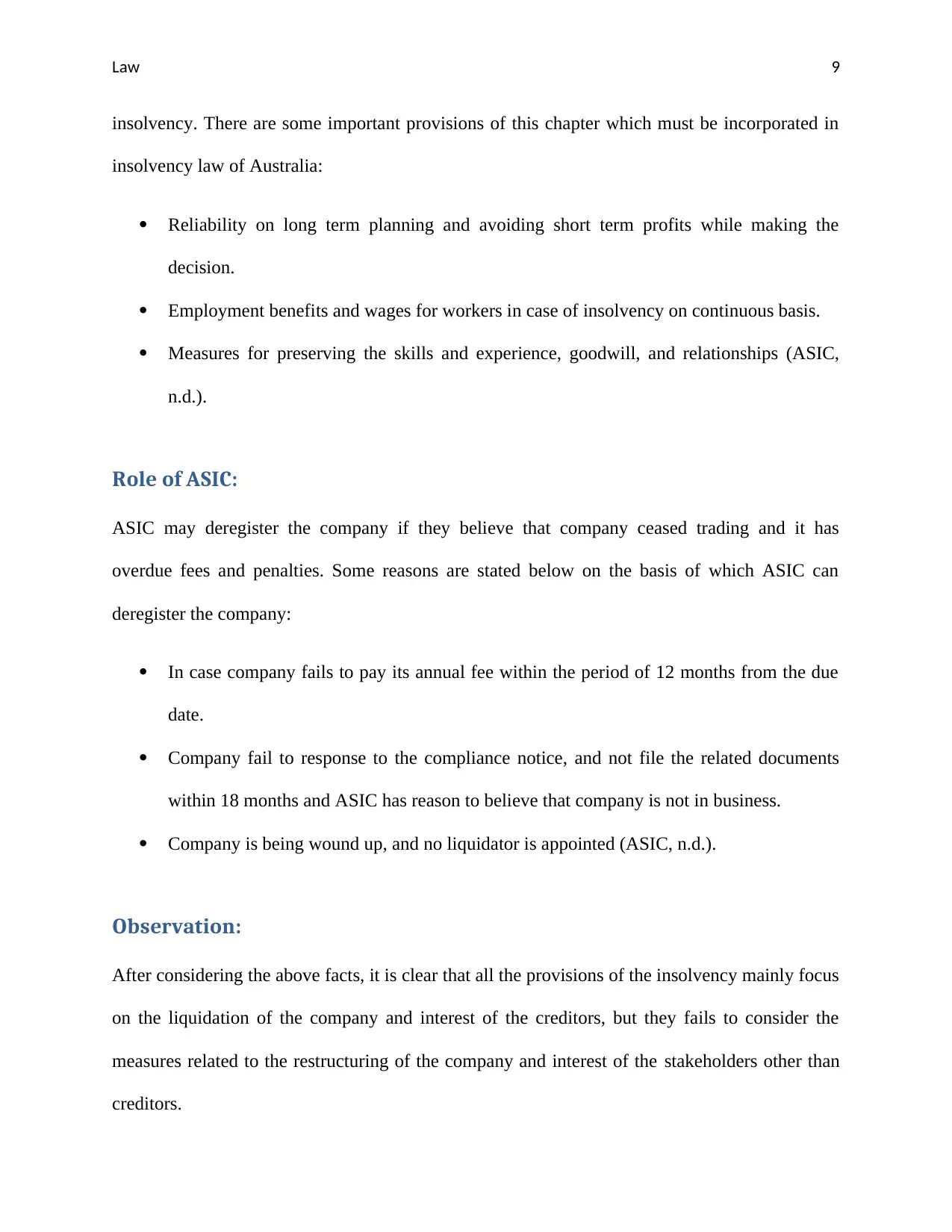
Law 9
insolvency. There are some important provisions of this chapter which must be incorporated in
insolvency law of Australia:
Reliability on long term planning and avoiding short term profits while making the
decision.
Employment benefits and wages for workers in case of insolvency on continuous basis.
Measures for preserving the skills and experience, goodwill, and relationships (ASIC,
n.d.).
Role of ASIC:
ASIC may deregister the company if they believe that company ceased trading and it has
overdue fees and penalties. Some reasons are stated below on the basis of which ASIC can
deregister the company:
In case company fails to pay its annual fee within the period of 12 months from the due
date.
Company fail to response to the compliance notice, and not file the related documents
within 18 months and ASIC has reason to believe that company is not in business.
Company is being wound up, and no liquidator is appointed (ASIC, n.d.).
Observation:
After considering the above facts, it is clear that all the provisions of the insolvency mainly focus
on the liquidation of the company and interest of the creditors, but they fails to consider the
measures related to the restructuring of the company and interest of the stakeholders other than
creditors.
insolvency. There are some important provisions of this chapter which must be incorporated in
insolvency law of Australia:
Reliability on long term planning and avoiding short term profits while making the
decision.
Employment benefits and wages for workers in case of insolvency on continuous basis.
Measures for preserving the skills and experience, goodwill, and relationships (ASIC,
n.d.).
Role of ASIC:
ASIC may deregister the company if they believe that company ceased trading and it has
overdue fees and penalties. Some reasons are stated below on the basis of which ASIC can
deregister the company:
In case company fails to pay its annual fee within the period of 12 months from the due
date.
Company fail to response to the compliance notice, and not file the related documents
within 18 months and ASIC has reason to believe that company is not in business.
Company is being wound up, and no liquidator is appointed (ASIC, n.d.).
Observation:
After considering the above facts, it is clear that all the provisions of the insolvency mainly focus
on the liquidation of the company and interest of the creditors, but they fails to consider the
measures related to the restructuring of the company and interest of the stakeholders other than
creditors.
⊘ This is a preview!⊘
Do you want full access?
Subscribe today to unlock all pages.

Trusted by 1+ million students worldwide
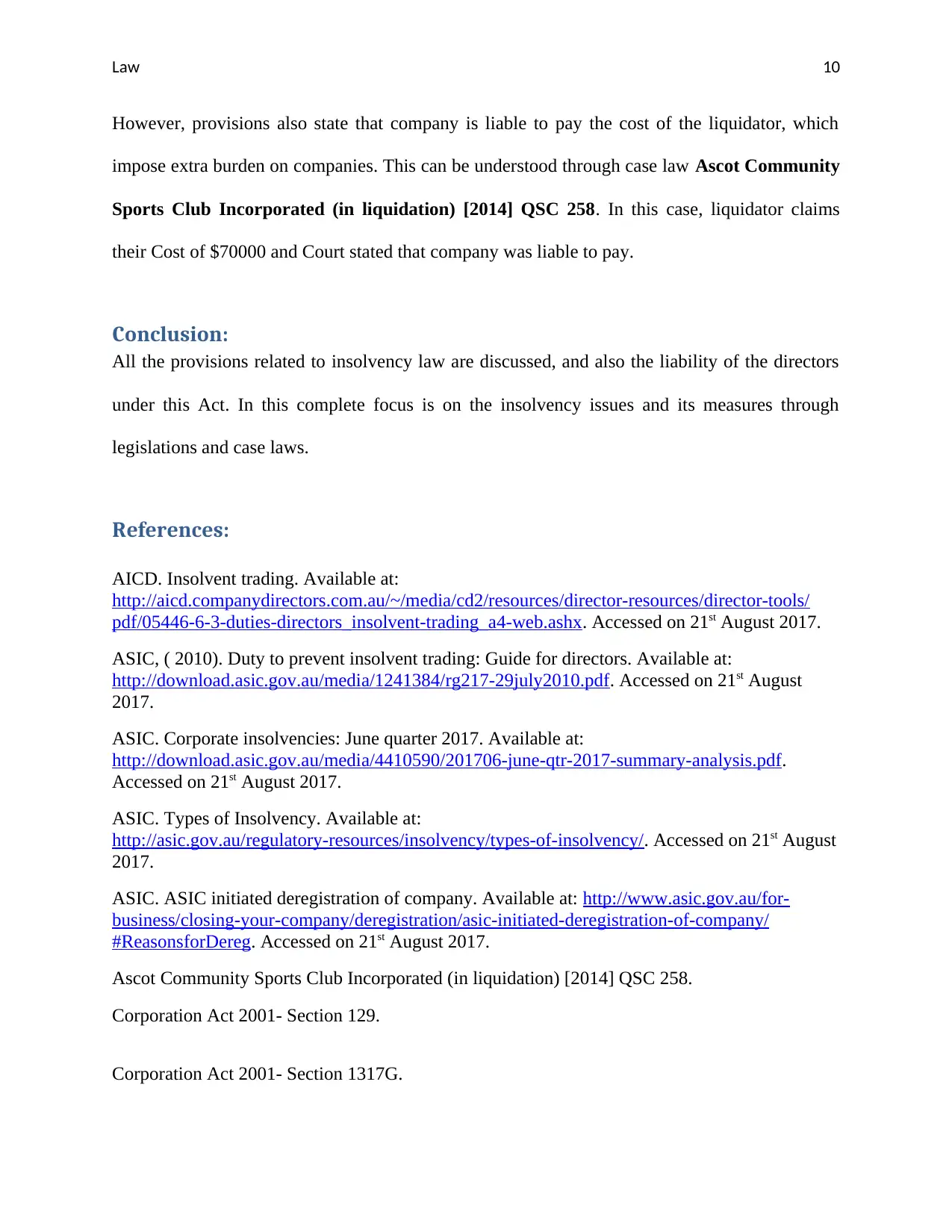
Law 10
However, provisions also state that company is liable to pay the cost of the liquidator, which
impose extra burden on companies. This can be understood through case law Ascot Community
Sports Club Incorporated (in liquidation) [2014] QSC 258. In this case, liquidator claims
their Cost of $70000 and Court stated that company was liable to pay.
Conclusion:
All the provisions related to insolvency law are discussed, and also the liability of the directors
under this Act. In this complete focus is on the insolvency issues and its measures through
legislations and case laws.
References:
AICD. Insolvent trading. Available at:
http://aicd.companydirectors.com.au/~/media/cd2/resources/director-resources/director-tools/
pdf/05446-6-3-duties-directors_insolvent-trading_a4-web.ashx. Accessed on 21st August 2017.
ASIC, ( 2010). Duty to prevent insolvent trading: Guide for directors. Available at:
http://download.asic.gov.au/media/1241384/rg217-29july2010.pdf. Accessed on 21st August
2017.
ASIC. Corporate insolvencies: June quarter 2017. Available at:
http://download.asic.gov.au/media/4410590/201706-june-qtr-2017-summary-analysis.pdf.
Accessed on 21st August 2017.
ASIC. Types of Insolvency. Available at:
http://asic.gov.au/regulatory-resources/insolvency/types-of-insolvency/. Accessed on 21st August
2017.
ASIC. ASIC initiated deregistration of company. Available at: http://www.asic.gov.au/for-
business/closing-your-company/deregistration/asic-initiated-deregistration-of-company/
#ReasonsforDereg. Accessed on 21st August 2017.
Ascot Community Sports Club Incorporated (in liquidation) [2014] QSC 258.
Corporation Act 2001- Section 129.
Corporation Act 2001- Section 1317G.
However, provisions also state that company is liable to pay the cost of the liquidator, which
impose extra burden on companies. This can be understood through case law Ascot Community
Sports Club Incorporated (in liquidation) [2014] QSC 258. In this case, liquidator claims
their Cost of $70000 and Court stated that company was liable to pay.
Conclusion:
All the provisions related to insolvency law are discussed, and also the liability of the directors
under this Act. In this complete focus is on the insolvency issues and its measures through
legislations and case laws.
References:
AICD. Insolvent trading. Available at:
http://aicd.companydirectors.com.au/~/media/cd2/resources/director-resources/director-tools/
pdf/05446-6-3-duties-directors_insolvent-trading_a4-web.ashx. Accessed on 21st August 2017.
ASIC, ( 2010). Duty to prevent insolvent trading: Guide for directors. Available at:
http://download.asic.gov.au/media/1241384/rg217-29july2010.pdf. Accessed on 21st August
2017.
ASIC. Corporate insolvencies: June quarter 2017. Available at:
http://download.asic.gov.au/media/4410590/201706-june-qtr-2017-summary-analysis.pdf.
Accessed on 21st August 2017.
ASIC. Types of Insolvency. Available at:
http://asic.gov.au/regulatory-resources/insolvency/types-of-insolvency/. Accessed on 21st August
2017.
ASIC. ASIC initiated deregistration of company. Available at: http://www.asic.gov.au/for-
business/closing-your-company/deregistration/asic-initiated-deregistration-of-company/
#ReasonsforDereg. Accessed on 21st August 2017.
Ascot Community Sports Club Incorporated (in liquidation) [2014] QSC 258.
Corporation Act 2001- Section 129.
Corporation Act 2001- Section 1317G.
Paraphrase This Document
Need a fresh take? Get an instant paraphrase of this document with our AI Paraphraser
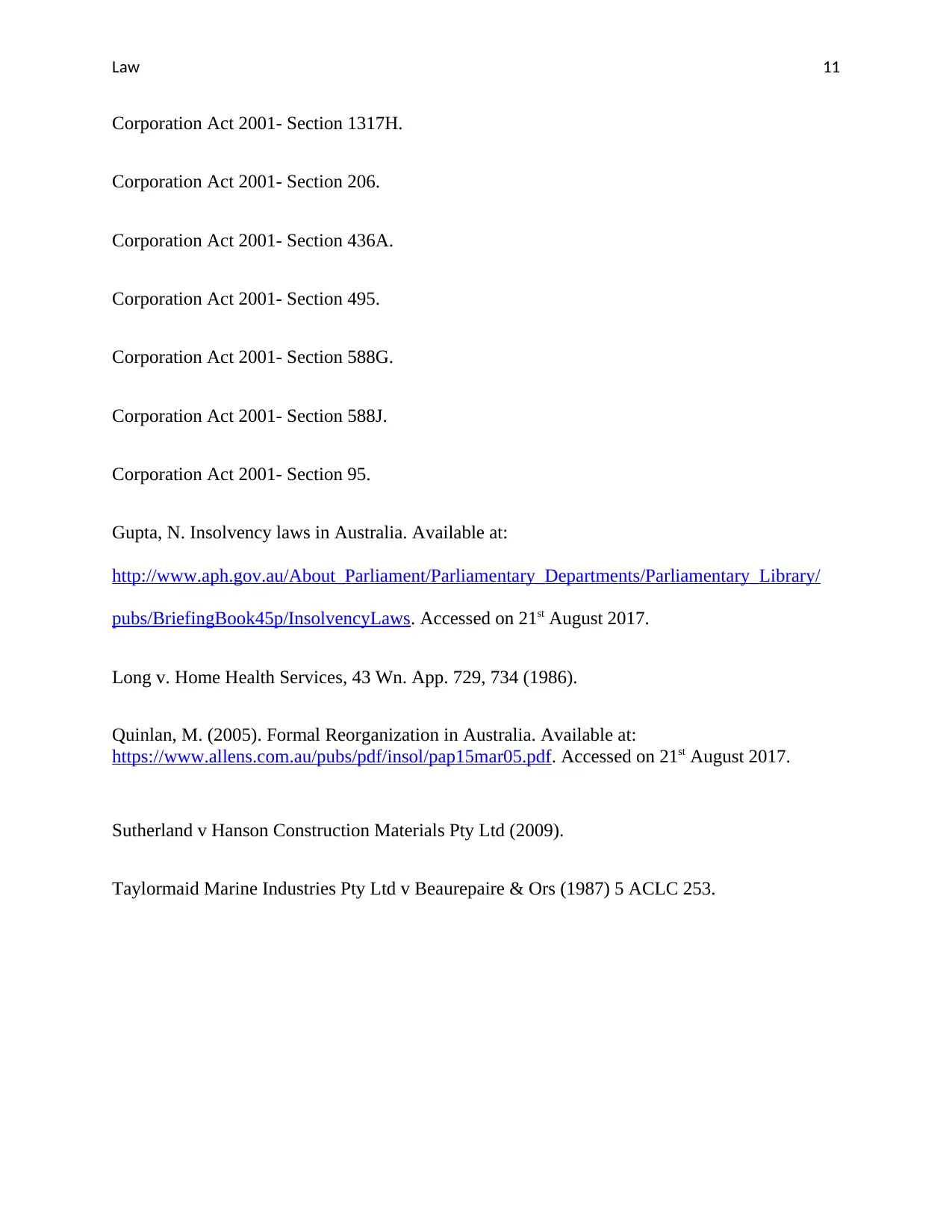
Law 11
Corporation Act 2001- Section 1317H.
Corporation Act 2001- Section 206.
Corporation Act 2001- Section 436A.
Corporation Act 2001- Section 495.
Corporation Act 2001- Section 588G.
Corporation Act 2001- Section 588J.
Corporation Act 2001- Section 95.
Gupta, N. Insolvency laws in Australia. Available at:
http://www.aph.gov.au/About_Parliament/Parliamentary_Departments/Parliamentary_Library/
pubs/BriefingBook45p/InsolvencyLaws. Accessed on 21st August 2017.
Long v. Home Health Services, 43 Wn. App. 729, 734 (1986).
Quinlan, M. (2005). Formal Reorganization in Australia. Available at:
https://www.allens.com.au/pubs/pdf/insol/pap15mar05.pdf. Accessed on 21st August 2017.
Sutherland v Hanson Construction Materials Pty Ltd (2009).
Taylormaid Marine Industries Pty Ltd v Beaurepaire & Ors (1987) 5 ACLC 253.
Corporation Act 2001- Section 1317H.
Corporation Act 2001- Section 206.
Corporation Act 2001- Section 436A.
Corporation Act 2001- Section 495.
Corporation Act 2001- Section 588G.
Corporation Act 2001- Section 588J.
Corporation Act 2001- Section 95.
Gupta, N. Insolvency laws in Australia. Available at:
http://www.aph.gov.au/About_Parliament/Parliamentary_Departments/Parliamentary_Library/
pubs/BriefingBook45p/InsolvencyLaws. Accessed on 21st August 2017.
Long v. Home Health Services, 43 Wn. App. 729, 734 (1986).
Quinlan, M. (2005). Formal Reorganization in Australia. Available at:
https://www.allens.com.au/pubs/pdf/insol/pap15mar05.pdf. Accessed on 21st August 2017.
Sutherland v Hanson Construction Materials Pty Ltd (2009).
Taylormaid Marine Industries Pty Ltd v Beaurepaire & Ors (1987) 5 ACLC 253.
1 out of 11
Related Documents
Your All-in-One AI-Powered Toolkit for Academic Success.
+13062052269
info@desklib.com
Available 24*7 on WhatsApp / Email
![[object Object]](/_next/static/media/star-bottom.7253800d.svg)
Unlock your academic potential
Copyright © 2020–2025 A2Z Services. All Rights Reserved. Developed and managed by ZUCOL.





